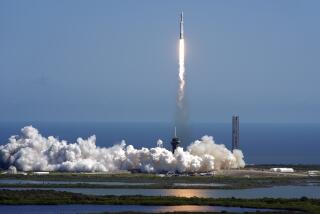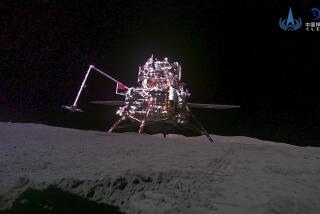Europeans, NASA Land a Big One: Saturn’s Titan
The European space probe Huygens hurtled through a poisonous atmosphere Friday and landed on Saturn’s frozen moon Titan, sending back images of what scientists were calling the strangest landscape in the solar system.
The first three images released by the European Space Agency revealed a rubble-filled surface of ice blocks and erosion-carved drainage channels that appear to lead to what could be a lake of liquid methane. Scientists hope images scheduled to be released today will help unravel lingering mysteries about why Titan has an atmosphere and whether the surface is hard as rock or covered in spongy hydrocarbons.
An audacious $3.3-billion space adventure combining the talents of engineers and scientists from two continents, the seven-year mission involved carrying the Huygens probe as a hitchhiker aboard the U.S.’s Cassini spacecraft. Released three weeks ago by Cassini, the probe flew itself to a picture-perfect landing on the most remote world ever visited.
Space scientists on both sides of the Atlantic Ocean declared the venture a “resounding success.”
“Unglaublich” (unbelievable), proclaimed a German scientist from the control center in Darmstadt, Germany, where the Huygens mission was managed.
“This is a great achievement for Europe and its U.S. partners in this ambitious international endeavor to explore the Saturnian system,” said European Space Agency Director General Jean-Jacques Dordain in Germany.
Much of the data collected by Huygens will take weeks or months to understand. Besides taking pictures, instruments on Huygens sampled the atmosphere, and scientists have just begun to analyze the data.
The Cassini-Huygens mission launched from Cape Canaveral on Oct. 15, 1997. The spacecraft arrived at Saturn in June, flew through its rings and then released the hubcap-shaped Huygens probe on Dec. 24. Over the last three weeks, the 9-foot-diameter probe flew solo on its way to the bizarre moon.
Its final two-hour descent to the moon’s surface was slowed from 12,400 mph by three sets of parachutes. The probe began broadcasting information back to Earth within four minutes of landing on the moon and continued broadcasting for more than an hour, about the limit of its battery power, scientists said.
Titan has been the subject of great scientific curiosity for the last 25 years, since Voyager 1 revealed what an odd world it was. Titan, discovered by Dutch astronomer Christiaan Huygens in 1655, is the only moon in the solar system with an atmosphere, one made up of methane and nitrogen, producing the orangish tint that until recently hid the surface from observers. It’s atmosphere is similar to Earthly smog.
In that way, it is thought to be a model of the early Earth, before life began and oxygen was produced by plants. Scientists are confident life could not develop on the surface of Titan because it is too cold at minus 290 degrees Fahrenheit. It is so far from the sun that the strength of the light reaching its surface is a thousand times less than on Earth.
Speculation over what the probe might find was as varied as cold liquid seas or a spongy, plastic-like surface.
One picture from the surface showed a barren, Mars-like landscape. The only difference was that the small, rounded boulders in the foreground were ice blocks, according to ESA researchers.
Torrence Johnson, a member of the mission’s camera team, said from the Jet Propulsion Laboratory in Pasadena that planetary surfaces “look pretty much the same everywhere.” That doesn’t mean strange things are not going on outside the camera’s eye. He said the lack of craters indicated the surface is young. Drainage channels show that something, perhaps hydrocarbon rivers, flowed across the surface at some point.
It was unclear exactly where the probe landed. Pictures taken during a Cassini fly-by several months ago showed bright and dark areas, but scientists could not estimate the elevations of those areas. Johnson said the new pictures seemed to prove that the bright, icy areas are at a higher elevation than the darkened surface, where he thought the probe had landed.
Some scientists had speculated that the dark areas were hydrocarbon seas, but the evidence from the probe seemed to show it to be a hard surface.
“This proves pretty conclusively there are not liquid oceans,” said Bob Mitchell, Cassini program manager at JPL. “That’s not to say there’s not lakes or ponds.”
Nonetheless, no one was complaining about the results.
“Titan was always the target in the Saturn system where the need for ‘ground truth’ from a probe was critical,” said David Southwood, director of ESA’s scientific program. “It is a fascinating world and we are now awaiting the scientific results.”
“The Huygens scientists are all delighted. This was worth the long wait,” said Jean-Pierre Lebreton, ESA’s Huygens mission manager.
Though Cassini-Huygens was a joint mission of NASA, ESA and the Italian Space Agency, Huygens was almost exclusively a European venture. The Americans were quick to congratulate their European colleagues.
“Descending through Titan was a once-in-a-lifetime opportunity, and today’s achievement proves that our partnership with ESA was an excellent one,” said Alphonso Diaz, NASA associate administrator of science, in Germany.
Mitchell said Huygens was a significant step forward for Europe in space. “I wouldn’t put it ahead of MER,” he said, referring to NASA’s twin rovers that have been driving over the Martian countryside for more than a year.
Among the Europeans, there seemed as much relief as joy, especially after some notable failures in their space program in recent years. Beagle 2, for instance, disappeared over Mars in December 2003.
Despite the success, it remained uncertain whether Huygens would be able to unravel Titan’s greatest mystery: Where is the methane in the atmosphere coming from? Even if it started out with a methane atmosphere, it wouldn’t take very long in geological time, 10 million years or so, for it to break up.
That implies that the organic compound, which is the principal component of natural gas, is being replenished, possibly from underground stores. Or perhaps it is trapped in Titan’s icy crust and being slowly released.
The fact that the surface is frigidly hostile doesn’t mean something is not going on under it. Scientists say it’s possible that water-ammonia mixtures were forced underground, where it could be warmer. It’s possible some of the material might even be liquid, scientists said.
Density measurements suggest Titan is about half rock silicate and half water ice.
*
(BEGIN TEXT OF INFOBOX)
Studying a distant moon
The Huygens probe conducted a successful landing on the surface of Titan on Friday. During its descent, onboard instruments analyzed the atmosphere and composition of Saturn’s largest moon.
1. Aerosol Collector Pyrolyzer: Studied clouds and aerosols in Titan’s atmosphere.
2. Doppler Wind Experiment: Studied winds and their effect on the probe during descent.
3. Descent Imager and Spectral Radiometer: Measured optical properties of aerosols and clouds and took spectral measurements of the atmosphere and surface. Imagers took a mosaic of pictures of the landing site.
4. Atmospheric Structure Instrument: Deduced atmospheric density and wind gusts.
5. Surface Science Package: Measured properties of Titan’s surface, including roughness and subsurface structure.
6. Gas Chromatograph and Mass Spectrometer: Measured chemical composition of gases and aerosols in Titan’s atmosphere.
Sources: NASA, European Space Agency






